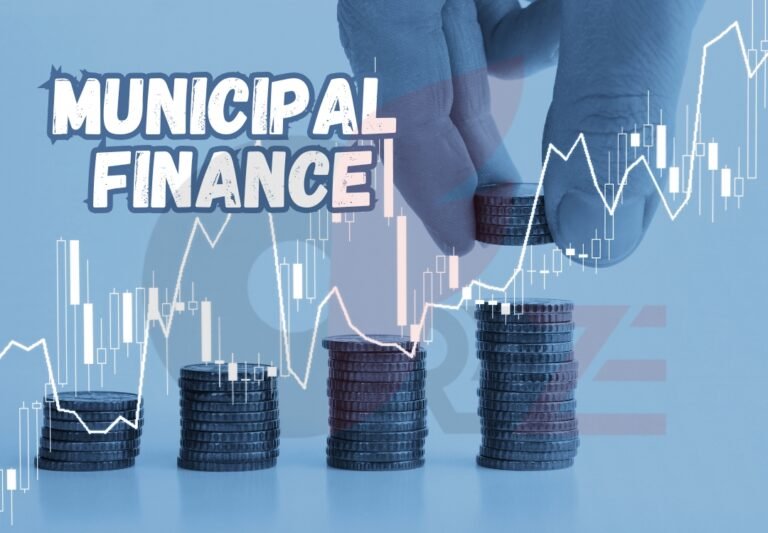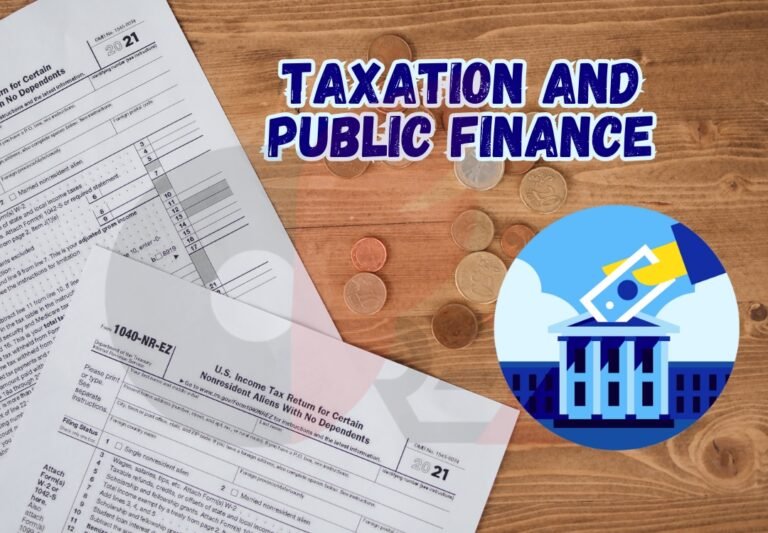The Role of Effective Public Debt Management
Effective Public Debt Management is crucial for maintaining fiscal stability, promoting long-term economic growth, and managing government finances sustainably. This comprehensive guide explores the key aspects of Public Debt Management, including its strategic objectives, the roles of debt managers, fiscal authorities, and central banks, and the importance of risk management. It delves into the major risks associated with public debt, such as interest rate, currency, refinancing, and liquidity risks, and provides insights into mitigating these risks using advanced techniques like hedging, diversification, and debt structuring.

The article also covers the importance of debt sustainability, examining the indicators that assess whether debt levels are manageable and how governments can balance debt servicing with economic growth. Learn about the challenges governments face, from political pressures and short-term borrowing decisions to the impact of external economic shocks. Additionally, the guide highlights best practices in Debt Management with case studies from both developed and emerging economies, offering actionable recommendations for improving debt management practices. Whether you’re a policymaker, debt manager, or investor, this detailed post provides the knowledge needed to understand and navigate the complexities of Public Debt Management for long-term economic stability.
Public Debt Management Introduction
Public Debt Management plays a crucial role in maintaining the economic stability and sustainability of any nation. It involves the management of a country’s debt obligations, ensuring that borrowing is done in an efficient, strategic, and responsible manner. Effective Public Debt Management is vital for promoting fiscal discipline, ensuring the government’s ability to meet its financial obligations, and reducing the risks associated with high levels of debt.
Managing public debt is not only about paying off loans but also about ensuring that a country’s debt profile aligns with its broader economic goals. The Debt Management Roles involve various government entities, such as fiscal authorities, debt managers, and central banks, working together to ensure the debt is sustainable, manageable, and supports long-term growth.
In this blog post, we’ll explore the importance of Public Debt Management, its objectives, the roles of key stakeholders, and the strategies involved in ensuring that public debt remains under control. We will also examine the challenges, best practices, and successful case studies from around the world to understand how effective debt management can contribute to economic growth and stability.
What is Public Debt Management?
Public Debt Management refers to the strategies and actions taken by governments to manage their debt obligations. This involves determining how much and what type of debt to issue, structuring debt in ways that minimize risk, and ensuring that borrowing aligns with the country’s fiscal and economic goals.
The core Debt Management Roles in this process typically fall to government agencies responsible for fiscal policy, debt issuance, and managing financial markets. These entities work together to ensure the country’s borrowing strategy does not jeopardize future economic stability or lead to financial crises.
One of the key objectives of Public Debt Management is debt sustainability. This means ensuring that the debt load remains manageable over time and does not threaten the government’s ability to meet future obligations. This requires careful planning and long-term forecasting, balancing short-term borrowing needs with long-term fiscal health.
Another significant objective is risk mitigation. Debt can expose a government to various risks, including interest rate fluctuations, currency risk (if borrowing is in foreign currencies), refinancing risks, and liquidity risks. Effective Public Debt Management incorporates risk assessment and mitigation strategies to ensure that the government can meet its debt obligations without sacrificing other important areas of public spending, such as healthcare, education, or infrastructure.
Ultimately, Public Debt Management involves making decisions that will allow a country to manage its debt efficiently while ensuring that borrowing does not become unsustainable and lead to debt crises.
The Key Roles in Public Debt Management
The management of public debt requires the involvement of several key stakeholders in government, each playing distinct Debt Management Roles to ensure a cohesive strategy.
Debt Managers are central to Public Debt Management. Their role is to oversee the issuance and management of government debt, ensuring that borrowing is done efficiently, at the best possible terms, and within the country’s fiscal policies. Debt managers often work within the Ministry of Finance or a similar government body, and they are tasked with creating strategies for debt issuance, repayment schedules, and managing risk exposures.
Fiscal Authorities, including ministers of finance and budget directors, are responsible for the overall fiscal policy of the government. Their role in Public Debt Management is to set the overall budgetary framework, determine borrowing needs, and ensure that public debt remains aligned with the government’s fiscal targets, such as deficit reduction or public spending goals.
Central Banks also play a vital role in Public Debt Management. They can influence the economy’s monetary policy, manage currency risks, and assist in managing government borrowing. Central banks also help regulate the financial markets where government debt is issued and traded, ensuring there is liquidity and stability in debt markets.
The key to successful Public Debt Management is the coordination between these entities. The Ministry of Finance sets fiscal policy and targets, debt managers implement borrowing strategies, and central banks help manage liquidity and market conditions. Regular communication and a collaborative approach are essential for reducing risks and optimizing borrowing strategies.
One of the challenges is maintaining a balance between short-term borrowing needs and long-term debt sustainability. Short-term borrowing may offer immediate financial relief, but it can result in future refinancing risks. Debt Managers must weigh the advantages of short-term borrowing against the potential long-term economic impact, such as higher interest rates or growing debt service costs.
Strategic Objectives in Managing Public Debt
Managing public debt isn’t simply about meeting current obligations; it’s about ensuring long-term stability, economic growth, and resilience. The strategic objectives of Public Debt Management focus on balancing economic needs while managing risks and ensuring fiscal responsibility. Let’s explore some of these key objectives.
1. Long-Term Goals: Debt Sustainability and Economic Stability
A primary goal of Public Debt Management is ensuring that the country’s debt remains sustainable over the long term. Debt sustainability is defined as a government’s ability to service its debt without compromising its financial stability or future economic growth. This involves ensuring that the debt-to-GDP ratio remains within manageable limits, and that debt repayments do not consume an excessive portion of the national budget.
Read More: Mastering Public Finance Management
Sustainable debt management allows governments to continue investing in critical sectors like healthcare, education, and infrastructure, while also meeting debt obligations. Without debt sustainability, governments risk defaulting on loans, which can lead to loss of investor confidence, economic instability, and potential financial crises.
2. Balancing Economic Growth and Debt Levels
Debt can be an effective tool for financing development, but it must be balanced with the need for economic growth. Borrowing to finance essential investments—such as infrastructure projects—can boost a country’s economic potential. However, excessive borrowing can stifle growth if debt service becomes too burdensome. A key objective of Public Debt Management is ensuring that borrowing is used productively and supports long-term growth rather than undermining fiscal health.
Effective debt management involves striking a balance between borrowing and investment. Governments must prioritize debt-financed projects that yield economic returns while also taking care not to exceed prudent debt levels. This balancing act is critical for maintaining economic stability and ensuring that borrowing does not crowd out essential public spending.
3. Importance of Transparency and Accountability
Transparency in Public Debt Management is critical for maintaining public trust and investor confidence. Governments must be clear about their debt levels, borrowing strategies, and debt service obligations. This transparency ensures that citizens and investors understand how government debt is being managed and what the risks might be.
Accountability also plays a vital role in maintaining fiscal discipline. Effective debt managers and policymakers must be accountable for ensuring that borrowed funds are spent responsibly, and that debt issuance remains within the limits set by fiscal policy. Without accountability, there is a risk of mismanagement, which could lead to unsustainable debt accumulation and loss of investor confidence.
Risk Management in Public Debt
Managing risk is an integral part of Public Debt Management. Debt introduces a variety of risks that can threaten a country’s financial stability if not carefully managed. Some of the most significant risks associated with public debt include interest rate risk, currency risk, refinancing risk, and liquidity risk. Effective Debt Management Roles involve identifying, assessing, and mitigating these risks through various strategies.
Identifying Risks: Interest Rate, Currency, Refinancing, and Liquidity Risks
- Interest Rate Risk: If a government borrows at variable interest rates, it faces the risk that rates may rise, increasing the cost of borrowing. This can lead to higher debt service payments, potentially straining government finances. Fixed-rate borrowing is one way to mitigate this risk.
- Currency Risk: Governments that borrow in foreign currencies are exposed to currency fluctuations. If the value of the local currency falls, the cost of servicing foreign-denominated debt increases. Currency risk can be mitigated through hedging or by borrowing in local currencies.
- Refinancing Risk: Governments often rely on refinancing to roll over maturing debt. If market conditions are unfavorable when debt comes due, it may become difficult or expensive to refinance. Careful planning and diversification of debt maturities can help reduce refinancing risk.
- Liquidity Risk: Liquidity risk arises when a government is unable to meet its short-term obligations due to insufficient cash flow. Governments manage this risk by maintaining adequate cash reserves and using short-term debt instruments.
Approaches to Managing Debt Risks: Hedging, Diversification, and Debt Structuring
To manage these risks, governments use a variety of strategies:
- Hedging: Governments may use financial instruments such as derivatives to hedge against interest rate and currency risks.
- Diversification: Borrowing from a variety of sources, including domestic and international markets, helps reduce the concentration of risk.
- Debt Structuring: By strategically structuring debt (e.g., varying maturities, interest rates, and currency denominations), governments can reduce exposure to individual risks.
The Role of Technology and Data in Risk Mitigation
In recent years, technological advances have played a significant role in improving Public Debt Management. Financial modeling tools, real-time data analysis, and advanced risk management software allow debt managers to identify potential risks early and make more informed decisions. Data analytics and technology help in forecasting future debt obligations, assessing market conditions, and optimizing debt strategies to minimize risks.
Public Debt Sustainability: Ensuring Long-Term Economic Stability
Public debt sustainability is a cornerstone of Public Debt Management. Without it, a country risks falling into a debt crisis, which can lead to economic turmoil, loss of investor confidence, and severe financial strain. Ensuring debt sustainability requires careful planning, monitoring, and evaluation of debt levels and economic performance.
- Defining Debt Sustainability and Its Significance
Debt sustainability refers to a country’s ability to service its debt without requiring excessive borrowing or jeopardizing economic growth. It means that the country can meet its debt obligations over time without resorting to default, and without placing an undue burden on future generations.
Key indicators used to assess debt sustainability include the debt-to-GDP ratio, the debt-service-to-revenue ratio, and fiscal balances. These metrics help policymakers assess whether the country’s debt load is manageable and whether the government can continue to meet its obligations without risking financial instability.
- Managing Debt Levels to Avoid Over-Indebtedness
An essential aspect of debt sustainability is avoiding over-indebtedness, which occurs when the level of debt exceeds what can be feasibly repaid. Over-indebtedness leads to debt crises, which can require external interventions, austerity measures, or even restructuring of the debt.
Governments must continuously monitor their debt levels, ensuring they do not grow faster than the economy. Policies that promote economic growth—such as improving productivity, investing in infrastructure, and promoting private sector development—help maintain a manageable debt load.
Challenges in Public Debt Management
Managing public debt can be complex, and there are several challenges that governments face in ensuring the sustainability and efficiency of their debt management strategies. These challenges arise from both internal and external factors, including political pressures, external economic shocks, and the potential for debt crises. Let’s explore these challenges in more detail.
1. Political Pressures and Short-Termism
One of the biggest challenges in Public Debt Management is political pressures. Governments often face the temptation to engage in short-term borrowing or to delay necessary fiscal reforms in order to meet immediate political goals. For example, policymakers may increase spending or borrow more to fund popular programs or to stimulate the economy ahead of an election. While this might be beneficial in the short run, it can exacerbate debt burdens in the long term, leading to unsustainable debt growth.
These short-term decisions can clash with the long-term objectives of Debt Management Roles, which include maintaining fiscal discipline, ensuring debt sustainability, and keeping borrowing costs under control. Political pressure can sometimes lead to borrowing decisions that are not fully aligned with sound fiscal policies, which can undermine a country’s economic stability and its ability to meet future debt obligations.
Effective Public Debt Management requires a commitment to long-term fiscal discipline, transparency, and the prioritization of economic stability over short-term political gains. A lack of this commitment can result in ballooning debt levels, higher interest payments, and an increased risk of default.
2. External Economic Shocks and Global Market Conditions
Global economic conditions can significantly affect a country’s ability to manage its public debt. External factors, such as global recessions, fluctuations in commodity prices, or changes in interest rates set by major central banks, can have a direct impact on government finances.
For example, a sudden downturn in global markets can lead to decreased government revenues (through lower tax collections or reduced exports) while increasing the cost of borrowing. Similarly, external shocks such as a global financial crisis or an unexpected geopolitical event can lead to higher borrowing costs or reduced investor confidence, making it harder for governments to issue debt on favorable terms.
Countries that rely heavily on external borrowing (e.g., in foreign currencies) are particularly vulnerable to exchange rate fluctuations, which can increase the burden of repaying debt. When the value of the local currency falls, the cost of foreign-denominated debt rises, putting additional strain on government finances.
Read More: Government Budgeting Process
In these circumstances, Public Debt Management strategies must be flexible enough to adjust to changing market conditions. Hedging techniques, diversification of debt portfolios, and maintaining a mix of domestic and foreign currency debt can help mitigate some of these risks.
3. Debt Crises and Their Impact on Developing Economies
One of the most severe challenges in Public Debt Management is the potential for debt crises, particularly in developing economies. A debt crisis occurs when a government is unable to meet its debt obligations, either because of an excessive debt burden, a lack of liquidity, or a sudden shift in economic conditions. This can result in default, the need for debt restructuring, or intervention from international organizations such as the International Monetary Fund (IMF).
Developing countries are often more susceptible to debt crises due to several factors, including limited access to global financial markets, lower credit ratings, and reliance on foreign-denominated debt. When these countries face a crisis, it can lead to social unrest, reduced public spending on essential services, and long-term economic stagnation. The recovery from a debt crisis can be slow and painful, with years of austerity measures and economic reforms needed to stabilize the economy.
Public Debt Management in developing economies must, therefore, focus on sustainable borrowing strategies, risk mitigation, and diversification of debt instruments to reduce the likelihood of a debt crisis. Countries in this category also benefit from having strong fiscal frameworks and transparent debt management practices to help build credibility with international investors.
Best Practices in Public Debt Management
Despite the challenges, many countries have successfully implemented strategies to manage their public debt effectively. By adopting best practices in Public Debt Management, governments can ensure fiscal stability, reduce debt-related risks, and create conditions for sustainable economic growth. Let’s look at some successful case studies from both developed and developing economies, as well as best practices for debt issuance and management.
1. Successful Case Studies from Developed Economies
Several developed countries have demonstrated effective Public Debt Management that has contributed to economic stability and long-term growth. One example is Germany, which has maintained a relatively low and stable debt-to-GDP ratio despite economic challenges. Germany’s fiscal discipline, coupled with its strong economic performance, has allowed it to issue debt at low-interest rates, reducing the cost of borrowing. The country’s emphasis on fiscal rules, including balanced budget amendments, and its commitment to avoiding excessive deficits has contributed to long-term debt sustainability.
Similarly, Canada has implemented sound debt management strategies, including transparent debt issuance practices and the use of a diversified debt portfolio. Canada’s government has consistently managed its debt in a way that keeps borrowing costs low while maintaining a stable fiscal position. This approach has helped the country avoid the pitfalls of excessive debt accumulation and has bolstered investor confidence.
2. Successful Case Studies from Developing Economies
Even in developing economies, Public Debt Management can lead to positive outcomes. For example, Chile has used a combination of fiscal prudence, debt diversification, and the establishment of a sovereign wealth fund to manage its debt effectively. By setting aside surplus revenues from copper exports during boom periods, Chile has been able to reduce its debt burden during downturns, ensuring greater fiscal stability.
Botswana, another example from Africa, has also excelled in Public Debt Management. Despite being a lower-middle-income country, Botswana has managed its debt prudently by keeping borrowing levels relatively low and prioritizing investment in infrastructure and education. The country has used a mix of domestic and external debt to ensure access to capital while managing risks.
3. Best Practices for Debt Issuance and Management
Some key best practices that can help improve Public Debt Management include:
- Developing a comprehensive debt management strategy: Governments should have clear strategies for managing their debt portfolios, including guidelines for borrowing, risk mitigation, and debt servicing.
- Implementing transparent debt issuance processes: Transparency ensures that debt managers communicate openly with the public and investors about the country’s debt profile, borrowing needs, and repayment schedules. This helps build trust and credibility in financial markets.
- Diversifying debt instruments: Governments should issue debt in a variety of forms, including bonds, loans, and short-term debt, to reduce reliance on any one source of borrowing. This helps spread risk and manage costs effectively.
- Prioritizing debt sustainability: The long-term objective of debt management should be sustainability. Governments should prioritize borrowing for projects that generate long-term economic benefits and avoid excessive short-term borrowing that could lead to future crises.
- Using risk management tools: Debt managers can employ financial instruments like hedging, interest rate swaps, and currency swaps to manage exposure to interest rate and currency risks. This can help reduce the volatility of debt servicing costs.
4. Recommendations for Improving Debt Management in Emerging Economies
For emerging economies, adopting these best practices can be challenging due to limited access to financial markets, lower investor confidence, and higher risks of external shocks. However, there are several strategies these countries can adopt to improve their Public Debt Management:
Read More: Public Finance Policies
- Building stronger fiscal institutions: Strong institutions that are independent of political interference can help ensure sound fiscal policies and better management of public debt.
- Improving debt transparency: Increased transparency in debt issuance and management practices can build trust with investors and international financial institutions, leading to better borrowing terms and lower risk premiums.
- Strengthening economic fundamentals: Promoting economic growth, reducing inflation, and maintaining stable exchange rates can create a more favorable environment for managing public debt.
Conclusion
In conclusion, Public Debt Management is an essential function for any government seeking to maintain fiscal discipline, ensure economic stability, and promote long-term growth. By understanding the strategic objectives of debt management, coordinating efforts across key government institutions, and adopting best practices, countries can reduce the risks associated with high levels of debt and ensure that borrowing serves to support, rather than undermine, economic prosperity.
Governments must remain vigilant in managing risks, addressing challenges like political pressures, external shocks, and the potential for debt crises. By learning from successful case studies and adopting sound debt management practices, both developed and developing economies can ensure that their debt remains sustainable and manageable.
Ultimately, the role of Debt Management Roles is to strike a delicate balance between borrowing to finance growth and ensuring that debt levels remain within sustainable limits. With effective Public Debt Management, governments can maintain fiscal stability, attract investment, and create the conditions necessary for long-term economic prosperity.
FAQs
Here are the best 5 frequently asked questions about The Role of Effective Public Debt Management:
1: How Can Public Debt Management Contribute to Economic Stability and Growth?
Public Debt Management plays a pivotal role in ensuring the economic stability of a nation. It involves strategic planning to handle borrowing, manage risks, and reduce debt-related pressures. But how exactly does it contribute to long-term growth?
At its core, Public Debt Management focuses on balancing borrowing needs with the ability to repay debt without sacrificing the nation’s financial stability. When managed properly, debt can be a powerful tool for economic growth. For instance, borrowing to finance infrastructure projects or social programs can stimulate economic activity and improve productivity, laying the foundation for future growth.
However, the key lies in managing debt levels sustainably. Countries that have well-structured debt programs, with clear repayment plans, are able to invest in growth-promoting activities while maintaining the confidence of investors and international financial institutions. Debt should not become an obstacle to growth—if properly managed, it can actually fuel it.
Effective Debt Management Roles are critical in this process. Debt managers, fiscal authorities, and central banks all play distinct but complementary roles in ensuring that borrowing aligns with economic objectives. Through efficient risk management strategies, such as diversifying debt portfolios and using financial instruments to hedge against interest rate and currency risks, governments can minimize exposure to financial shocks.
For example, Germany has successfully managed its public debt to ensure long-term economic stability. By adhering to strict fiscal rules and ensuring that borrowing is directed towards high-return projects, Germany has been able to maintain a low debt-to-GDP ratio and keep borrowing costs low, which has bolstered its economic strength over time.
In contrast, countries that borrow excessively or without adequate planning can face rising debt burdens that eat into government budgets and limit the resources available for development. Ultimately, the strategic management of public debt is essential for creating an environment that encourages investment, boosts economic activity, and ensures fiscal sustainability.
2: What Are the Key Risks Involved in Public Debt, and How Can They Be Mitigated?
Managing public debt comes with inherent risks, and governments must understand these risks in order to safeguard economic stability. The most significant risks in Public Debt Management include interest rate risk, currency risk, refinancing risk, and liquidity risk. But what do these risks mean, and how can they be mitigated?
- Interest Rate Risk arises when a government borrows at variable interest rates. If market rates rise, the cost of servicing debt increases, leading to higher fiscal pressures. This can be mitigated by issuing debt at fixed interest rates, which locks in costs over the life of the debt.
- Currency Risk is particularly relevant for countries that borrow in foreign currencies. If the national currency depreciates, the cost of repaying foreign-denominated debt increases, putting additional strain on government finances. Hedging strategies and issuing debt in local currency are common ways to reduce currency risk.
- Refinancing Risk occurs when debt must be rolled over or refinanced at the time of maturity. If market conditions are unfavorable, such as rising interest rates or poor investor sentiment, the government may face challenges in refinancing its debt on favorable terms. Governments can mitigate refinancing risk by staggering debt maturities and maintaining a buffer of cash reserves to meet short-term obligations.
- Liquidity Risk arises when a government is unable to meet its short-term debt obligations because it doesn’t have enough cash flow. This risk can be mitigated by maintaining sufficient reserves or using short-term debt instruments to address temporary liquidity gaps.
Governments can use several strategies to manage these risks effectively. A well-diversified debt portfolio, including both short-term and long-term debt, domestic and foreign debt, and fixed and floating rates, can help spread risk across different instruments. Furthermore, utilizing advanced risk management tools such as hedging, interest rate swaps, and currency swaps can significantly reduce the impact of market volatility.
In addition, technology plays a key role in risk mitigation. Governments can use financial modeling, data analytics, and real-time market insights to make informed decisions and better forecast potential risks.
In summary, Public Debt Management involves identifying potential risks early and taking proactive measures to ensure that debt remains sustainable and manageable. By adopting a comprehensive risk management strategy, governments can protect their economies from the adverse effects of these risks and ensure fiscal stability.
3: What Are the Long-Term Goals of Public Debt Management, and Why Are They Important?
Effective Public Debt Management is not just about meeting immediate financing needs—it’s also about ensuring long-term economic stability and sustainability. But what are the long-term goals of managing public debt, and why do they matter?
One of the primary long-term objectives is debt sustainability. This refers to the ability of a government to service its debt over time without incurring excessive debt burdens or risking default. The goal is to ensure that a country’s debt-to-GDP ratio remains within manageable limits, and that debt repayments don’t crowd out other essential government spending, such as on infrastructure, healthcare, and education.
Sustainable debt management is critical because it provides confidence to investors and markets. When investors believe that a country’s debt is sustainable and that the government can meet its obligations, they are more likely to lend at favorable terms, keeping borrowing costs low. On the other hand, a country with unsustainable debt risks higher borrowing costs, a reduced credit rating, and even the possibility of default.
Economic stability is another key long-term goal. When public debt is managed effectively, it helps to stabilize the economy by ensuring that debt levels are aligned with fiscal capacity. Governments can then focus on promoting growth through investment in key sectors without being hampered by rising debt service costs.
A third critical objective is the promotion of economic growth. Debt, when used properly, can finance investments that fuel growth—such as in infrastructure, technology, and education. Borrowing to fund these investments can create a positive feedback loop, as improved infrastructure and education can enhance productivity, boost exports, and generate additional government revenues. This, in turn, allows for continued investment in future growth.
The importance of these long-term goals cannot be overstated. If a government fails to manage its debt sustainably, it risks creating a cycle of rising debt, higher borrowing costs, and eventually, financial instability. Conversely, by achieving long-term goals of sustainability, economic stability, and growth, governments can create an environment that fosters investor confidence, supports development, and drives long-term prosperity.
4: How Do Political Pressures Affect Public Debt Management, and What Can Be Done About It?
Political pressures can significantly impact Public Debt Management, often leading to short-term decisions that may not align with long-term fiscal health. But how do these pressures affect debt management, and what can be done to minimize their impact?
Governments are often under political pressure to meet immediate spending needs, particularly in times of economic or social challenges. For example, there may be calls to increase public spending on healthcare, infrastructure, or social programs to address pressing issues, such as unemployment or poverty. While these programs are important, the temptation to borrow excessively to fund them can lead to unsustainable debt levels.
Short-term political cycles, particularly in countries with frequent elections, also make it difficult to prioritize long-term fiscal discipline. Politicians may avoid making tough decisions about cutting spending or increasing taxes because these actions are often unpopular with voters. Instead, they may choose to borrow more to finance government expenditures, which could eventually lead to higher debt and greater fiscal risks.
Read More: Fiscal Policy and Public Finance
The key to mitigating the effects of political pressures on Public Debt Management lies in fostering a culture of fiscal responsibility and ensuring that debt management is insulated from political influence. Independent fiscal institutions, such as debt management offices and central banks, can help ensure that borrowing decisions are made based on economic realities rather than political expediency. Additionally, adopting fiscal rules—such as limits on the debt-to-GDP ratio or budget deficit—can help provide a framework for long-term debt sustainability.
Public transparency is also essential in reducing the impact of political pressures. By providing regular updates on the country’s debt levels, borrowing plans, and repayment schedules, governments can foster accountability and discourage short-term, unsustainable borrowing.
Ultimately, ensuring that Public Debt Management is guided by long-term fiscal goals, rather than short-term political gain, is crucial for maintaining economic stability and avoiding the pitfalls of excessive borrowing.
5: How Can Technology and Data Improve Public Debt Management Practices?
The integration of technology and data has transformed the landscape of Public Debt Management. But how exactly can these tools improve the effectiveness of managing a nation’s debt?
Technology enables governments to make more informed decisions by providing real-time access to financial markets, allowing debt managers to adjust strategies based on changing conditions. Advanced analytics can be used to model debt scenarios, forecast future debt obligations, and assess the impact of various debt instruments on the country’s fiscal health. This allows policymakers to make better-informed decisions about borrowing, debt structure, and risk management.
For example, governments can use financial modeling software to simulate the potential effects of different borrowing strategies under various market conditions, such as changes in interest rates or exchange rates. These models can help identify the most cost-effective debt instruments and repayment schedules, minimizing the risk of excessive debt service costs down the line.
Data analytics also plays a critical role in risk management. By analyzing patterns in financial markets, governments can anticipate potential risks—such as interest rate hikes or currency fluctuations—and take steps to mitigate them. Technologies like blockchain can also improve transparency in debt issuance, making it easier for investors and the public to track government borrowing and spending.
Furthermore, the use of big data and artificial intelligence allows debt managers to make more accurate predictions about economic trends and potential financial risks. By incorporating these advanced tools into debt management practices, governments can increase the accuracy of their fiscal projections and ensure that debt remains sustainable over the long term.
In conclusion, technology and data-driven insights are transforming how Public Debt Management is approached. By leveraging these tools, governments can make more informed, timely decisions, reduce risks, and ultimately enhance their ability to manage debt effectively and sustainably.






